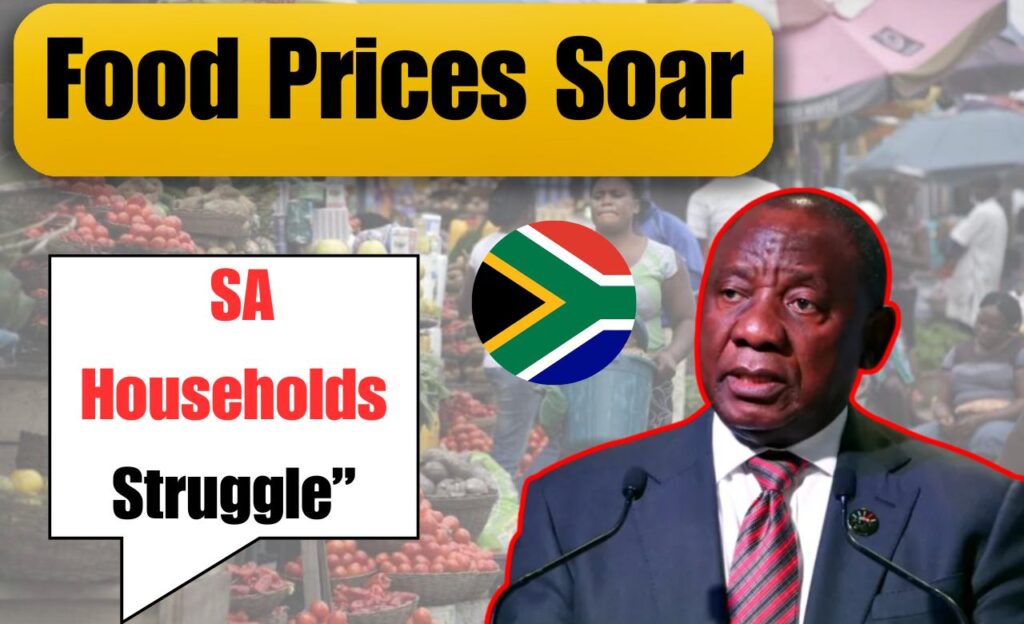South African households are facing a difficult October 2025 as essential food prices such as bread, cooking oil, and maize meal continue to surge. According to recent market trends, inflation in the food sector has reached its highest point in over a year, putting pressure on middle- and low-income families. Experts blame global supply chain disruptions, drought in key farming regions, and higher transport costs for this price spike. The government is monitoring the situation closely, but consumers are urged to budget wisely and look for local market alternatives to manage rising living costs.

Rising Bread Prices Affecting South African Families
The price of bread, one of the most essential items in South African households, has jumped by nearly 15% in October 2025 compared to the same period last year. This steep increase has made it harder for families to afford daily meals, especially in lower-income regions. Analysts say wheat shortages, higher import duties, and the weakening rand have contributed to this inflation. While government food subsidies are being discussed, no direct relief has been implemented yet. Many South Africans are now turning to local bakeries and community co-ops to access cheaper alternatives and manage expenses.
Cooking Oil Prices Continue to Climb Across South Africa
Cooking oil prices have become another major burden on South African consumers. As of October 2025, the cost per liter has increased by nearly 20%, impacting small businesses, restaurants, and households alike. Experts cite global vegetable oil shortages, high transport costs, and ongoing trade restrictions as key reasons for this rise. The Competition Commission is also investigating possible price manipulation in the market. To help manage expenses, consumers are encouraged to buy in bulk, switch to alternative oils, and monitor local store discounts through online shopping platforms.
Also Read : SASSA Pension Grant September 2025 — Full List of Amounts, Dates & Changes
Government Response and Relief Measures Under Review
The South African government, through the Department of Trade, Industry and Competition, has acknowledged the mounting pressure of rising food costs. Officials are exploring ways to stabilize prices through import duty reductions and agricultural subsidies. The Treasury is also reviewing potential food voucher programs for low-income families if inflation persists beyond December 2025. In addition, agricultural experts are pushing for stronger support to local farmers to improve domestic food production and reduce dependence on imports. Meanwhile, citizens are advised to track updates through official government portals and budget advisory tools.
Impact on South African Economy and Consumer Behavior
The rising cost of bread and oil is reshaping consumer habits in South Africa. Many households have started reducing non-essential spending, focusing more on staple foods. Restaurants are adjusting menus, and small retailers are struggling to maintain affordable prices. Economists warn that if food inflation remains above 10%, overall household purchasing power could drop significantly by the end of 2025. However, experts also believe that improved local farming support and global market corrections could bring some relief by early 2026.
| Item | Average Price (2024) | Average Price (Oct 2025) | Percentage Increase | Reason for Price Hike |
|---|---|---|---|---|
| White Bread (Loaf) | R15.50 | R18.00 | +16% | Wheat shortage & import costs |
| Cooking Oil (1L) | R38.00 | R45.50 | +19% | Global vegetable oil shortage |
| Maize Meal (10kg) | R95.00 | R108.00 | +13% | Drought in local regions |
| Flour (2.5kg) | R42.00 | R49.00 | +17% | Rising fuel and transport costs |
| Sunflower Oil (2L) | R78.00 | R92.00 | +18% | Import restrictions & demand |
Also Read : SA Update: R2,190 Care Grant Goes Live This October – Who Qualifies and When You’ll Be Paid
FAQs
Q1: Why are food prices rising so sharply in South Africa?
A1: Due to global shortages, drought, and higher fuel costs.
Q2: Which food items are most affected in October 2025?
A2: Bread, cooking oil, and maize meal have seen the highest increases.
Q3: Is the government offering any relief?
A3: Relief programs and subsidies are under review for late 2025.
Q4: When will food prices stabilize?
A4: Experts expect slight improvement by early 2026 if supply normalizes.



